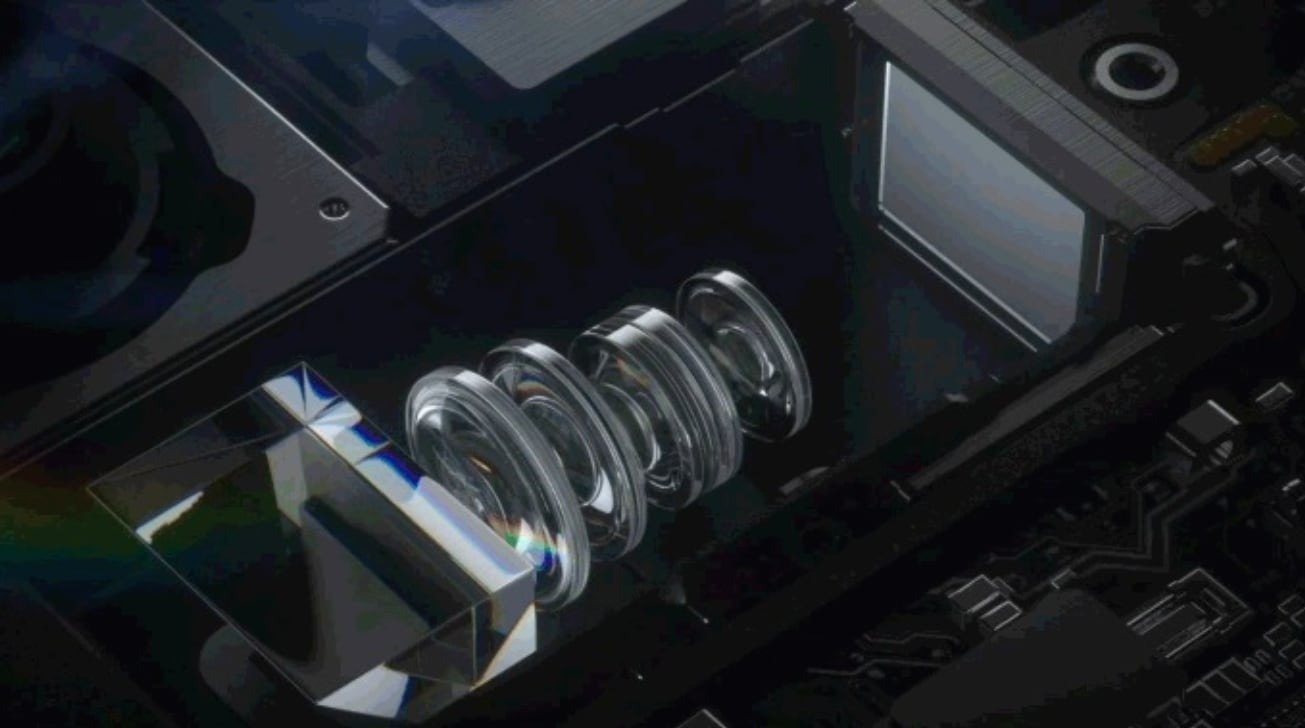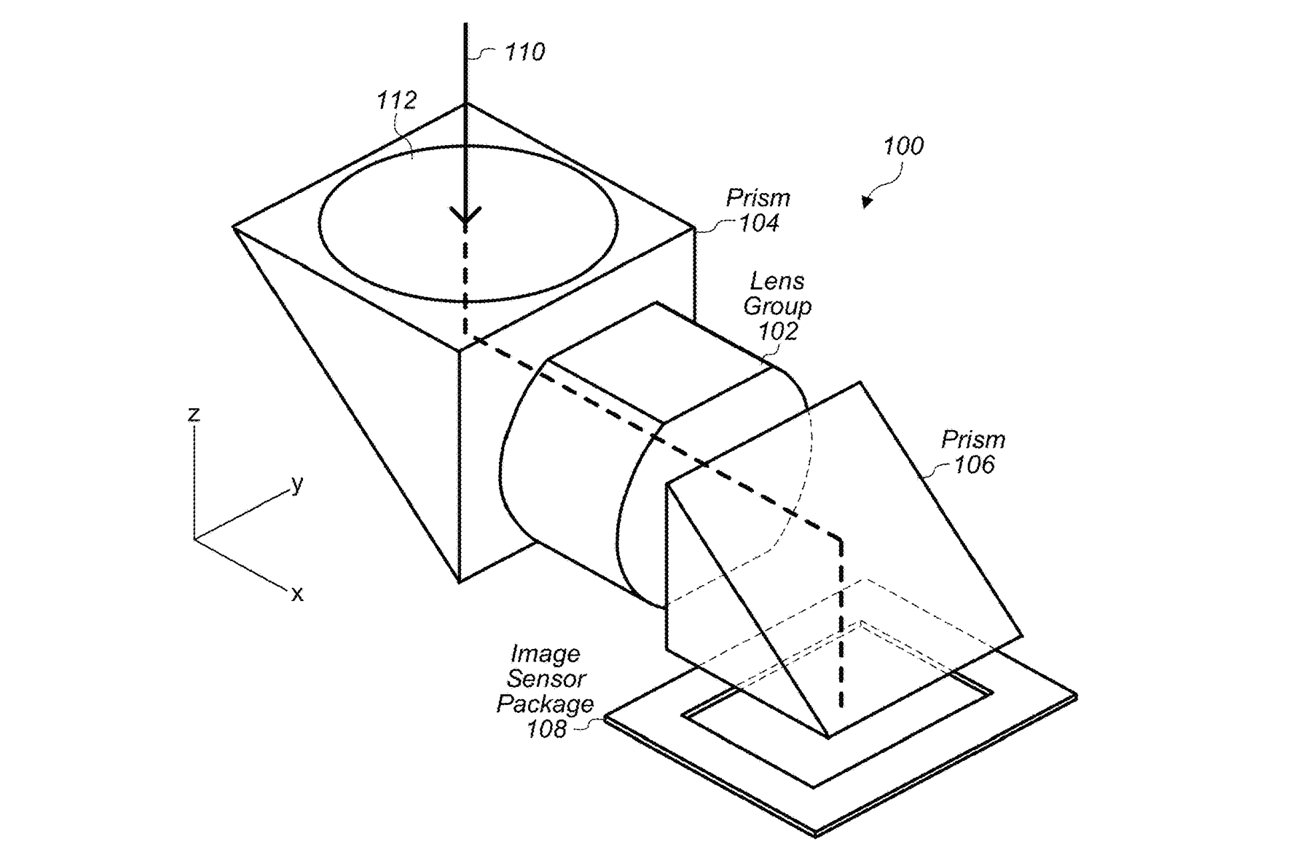The expected periscope camera system in a future iPhone could include actuators, allowing the lens to move for autofocus and optical image stabilization applications, without requiring a massive camera bump increase.
Apple's use of a triple camera system in the iPhone 12 Pro gives a wide optical zoom range to its users. The use of three camera sensors is needed in such cases, as there's not enough thickness in the device to enable a zoom lens to be used.
One way around that is a concept that has started to surface in some devices, referred to as periscope cameras and folded cameras, as used in Samsung's Galaxy S20. These systems rely on an arrangement of lenses that reflect light at an angle, taking advantage of the width of the smartphone rather than the thickness.
Apple has been rumored to be working on a form of folding camera, intended for use in a future iPhone model.
While doing so can enable extremely long focal lengths, it does still rely on other elements to function. Chiefly, to allow for a range of focal lengths, the lens arrangement must be able to move, which entails creating a way to mount the lenses and to shift them around.
In a newly granted patent titled "Folded camera with actuator for moving optics," Apple comes up with a number of ways to include folded optics and lens-shifting capabilities in a device.
In various embodiments, Apple suggests that the system could consist of two prisms, with a lens group of multiple elements between the pair. The prisms divert light along an axis to an imaging sensor, while the lens group handles various optical functions.
The lens group could be held in an inner carrier structure, which itself is connected to an outer carrier structure. Both structures can be moved, with one moving at right angles to the other, allowing for a lot of changes in angle and placement of the lens arrangement.
 The patent deals with ways to mount or suspend the lens arrangements to offer OIS and autofocus capabilities.
The patent deals with ways to mount or suspend the lens arrangements to offer OIS and autofocus capabilities. There is the suggestion a voice coil motor actuator could be used to move the two carriers together, to provide autofocus capabilities. A second and third VCM actuator could be used to shift the inner carrier structure relative to the outer one, to provide optical image stabilization.
Some variations of the theme describes actuator modules that use one or multiple magnets or coils. Leaf springs and suspension wires could also be incorporated into the suspension arrangement to allow the movement of the carriers freely, as well as to return them to a base position.
The patent lists its inventors as Nicholas D. Smyth, Alfred N. Mireault, Scott W. Miller, and Shashank Sharma. It was originally filed on January 25, 2019.
Apple files numerous patent applications on a weekly basis, but while the existence of a patent indicates areas of interest for Apple's research and development purposes, they don't guarantee the idea will appear in a future product or service.
In 2016, a patent floated for a compact lens system that used a mirror to reflect light at an angle just once, giving a small increase in distance while still employing a closely-held collection of lenses. In 2019, it had updated the concept with a stack of lenses and a prism, still continuing to shoot at a 90-degree angle rather than operating like a periscope.
In January 2021, a patent for a "camera including two light folding elements" proposed using two prisms either side of a lens system, similar to the newest patent. A second July patent for the year covered the same sort of concept again.
The August folded camera patent differs from the others as it largely handles the mechanics of mounting and moving the lens arrangements, rather than covering the basic idea of folded cameras itself.
 Malcolm Owen
Malcolm Owen








-m.jpg)






 Thomas Sibilly
Thomas Sibilly
 Wesley Hilliard
Wesley Hilliard
 Marko Zivkovic
Marko Zivkovic



 Amber Neely
Amber Neely








11 Comments
If this results in an optical zoom capability competitive with a SLR camera, not to mention optical stabilization, this would be huge.
I think this is good for Apple. In the past, Android reigned supreme, in particular Samsung in the area of optical and imagery of smartphones.
Apple finally GETS it. Their users want a GOOD smartphone camera, not just ok. Virtually any smartphone, regardless of price these days, arguably takes GREAT pics in daylight.
We are seeing Samsung no longer as the leader. We have Google Pixel and *cough* Huawei doing better than Samsung. Of course, Sony with their fanboys (there's only a few of them left) will troll the web and their social circle promoting the next Sony Xperia phone with it's ridiculous price tag.
In any event, these improvements will result in a basic premium iPhone model costing more than $2000 US. The mobile phone industry will continue to
brainwashcondition consumers that this is an acceptable price to pay. Mobile providers will continue to be creative in their financing options. And finally, this pandemic will not end for many more years thanks to selfish governments who ignore science and prioritize their career, the economy, and covidiots over the health and safety of everyone.We'll see how these moving parts deal with vibration - say from a motorcycle mount. Even the best mounts don't kill vibration.